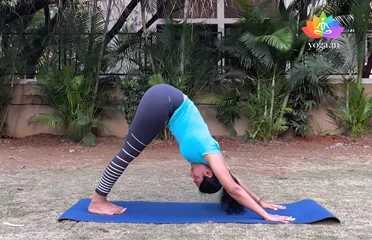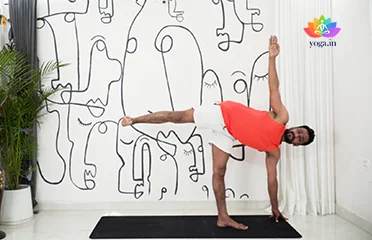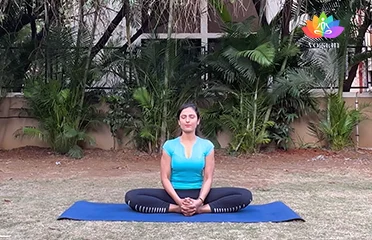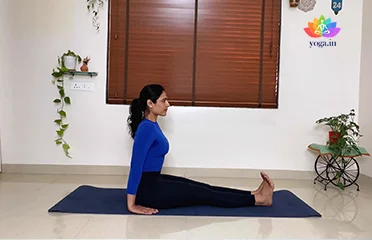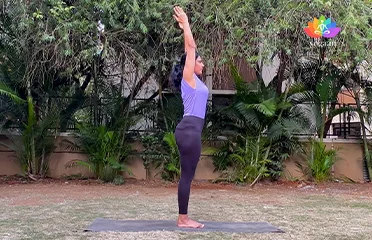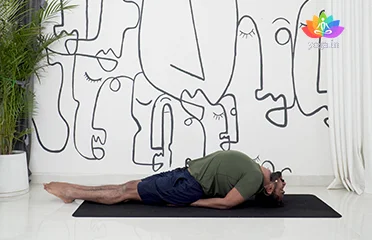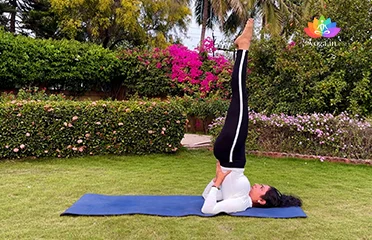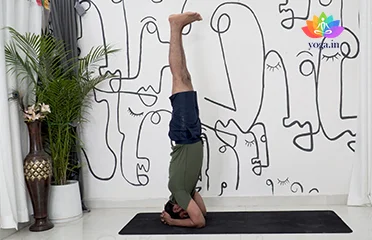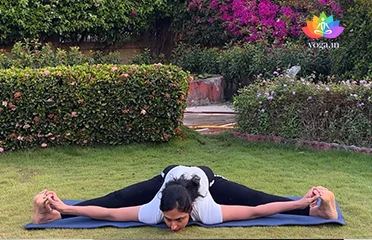Adho Mukha Svanasana (Downward-Facing Do
अधोमुख श्वानासन / Downward-Facing Dog Pose
The sanskrit name is derived from adhas (अधस्) meaning down, mukha [�K]
Ardha Chandrasana (Half Moon Pose)
अर्धचन्द्रासना / Half Moon Pose
The Sanskrit name is derived from Ardha (अर्ध) meaning half, Chandra [�K]
Bhadrasana (Gracious Pose | Butterfly Po
भद्रासन / Gracious Pose | Butterfly Pose
The Sanskrit name is derived from Bhadra (भद्रा) meaning gracious, [�K]
Dandasana (Stick Pose)
दण्डासन / Stick Pose
The Sanskrit name is derived from Danda (दण्डा) meaning stick and [�K]
Hastapadasana (Hand to Foot Pose)
हस्तपदासन / Hand to Foot Pose
The sanskrit name is derived from hasta (हस्त) means hands, pada (पदा) [�K]
Matsyasana (Fish Pose)
मत्स्यासनI / Fish Pose
The Sanskrit name is derived from Matsya (मत्स्या) meaning fish [�K]
Pincha Mayurasana (Peacock Feather Pose)
पिंचमयूरासन / Peacock Feather Pose
The Sanskrit name is derived from Pincha (पिंच) meaning feathered, Mayur [�K]
Sarvangasana (Shoulderstand)
सर्वाङ्गासनI / Shoulderstand
The Sanskrit name is derived from Sarva (सर्वाङ्ग) meaning all, [�K]
Sirsasana (Headstand)
शीर्षासन / Headstand
The Sanskrit name is derived from Sirsa (शीर्ष) meaning head and asana [�K]
Upavishta Konasana (Wide-Angled Seated F
उपविष्ट कोनासन / Wide-Angled Seated Forward Bend
The Sanskrit name is derived from Upavistha (उपविष्ट) means open/seated, [�K]
- 1
- 2
How Yoga Can Help Cure Displacement of Uterus:
Displacement of uterus, also known as uterine prolapse, occurs when the uterus descends from its normal position into the vaginal canal. Yoga can be beneficial in treating and relieving the symptoms of uterine prolapse by strengthening the pelvic floor muscles, improving circulation to the pelvic region, and promoting overall pelvic health.
Understanding Displacement of Uterus:
Displacement of uterus, or uterine prolapse, refers to the downward descent of the uterus into the vaginal canal. This condition can occur due to weakened pelvic floor muscles, ligaments, and tissues that support the uterus. Factors such as childbirth, aging, obesity, and chronic coughing can contribute to uterine prolapse.
Yoga’s Role in Relieving Displacement of Uterus:
Yoga offers gentle yet effective practices to alleviate symptoms associated with uterine prolapse. Specific yoga poses and techniques focus on strengthening the pelvic floor, improving posture, and enhancing pelvic stability. These practices can help reduce discomfort, improve bladder control, and promote pelvic organ support.
Key Factors Contributing to Displacement of Uterus:
Several factors can contribute to uterine prolapse:
- Childbirth: Vaginal delivery can weaken pelvic floor muscles and ligaments.
- Aging: Natural aging processes can lead to pelvic organ descent.
- Obesity: Excess weight can strain pelvic structures.
- Chronic coughing: Prolonged coughing can increase intra-abdominal pressure, contributing to prolapse.
Symptoms of Displacement of Uterus:
Common symptoms of uterine prolapse include:
- Feeling of pressure or fullness in the pelvis
- Sensation of a bulge or tissue protruding from the vagina
- Pelvic pain or discomfort, especially during activity
- Difficulty urinating or having bowel movements
- Backache
- Urinary incontinence
Treatment of Displacement of Uterus through Yoga and Pranayama:
Yoga and pranayama can play a crucial role in managing uterine prolapse. Some beneficial practices include:
Specific Yoga Poses:
- Uttanasana (Standing Forward Bend): Strengthens the pelvic floor and improves circulation to the pelvic region.
- Baddha Konasana (Bound Angle Pose): Helps to open the hips and stretch the pelvic muscles.
- Utkatasana (Chair Pose): Strengthens the pelvic floor and core muscles.
Pranayama Exercises:
- Mula Bandha (Root Lock): Engages and strengthens the pelvic floor muscles.
- Dirga Pranayama (Three-Part Breath): Promotes relaxation and reduces stress, which can contribute to pelvic tension.
Diet for Displacement of Uterus:
A balanced diet rich in fiber and nutrients can support pelvic health and complement yoga treatment for uterine prolapse. Recommendations include:
- Consuming plenty of fruits, vegetables, and whole grains to maintain regular bowel movements.
- Drinking an adequate amount of water to stay hydrated and support healthy digestion.
- Limiting caffeine and alcohol, which can irritate the bladder and exacerbate prolapse symptoms.
Caution for Displacement of Uterus:
While practicing yoga for uterine prolapse, it is essential to:
- Listen to your body and avoid poses that cause discomfort or pain.
- Practice modifications and use props as needed to support pelvic alignment.
- Consult with a healthcare provider before starting any new exercise regimen, especially if you have a severe prolapse or other pelvic health concerns.
Contraindications for Displacement of Uterus:
Individuals with severe uterine prolapse or certain medical conditions should:
- Avoid high-impact and strenuous yoga practices that can exacerbate pelvic pressure.
- Refrain from poses that involve deep abdominal contractions or straining.
- Seek guidance from a qualified yoga instructor or pelvic health specialist for personalized modifications and contraindications.


